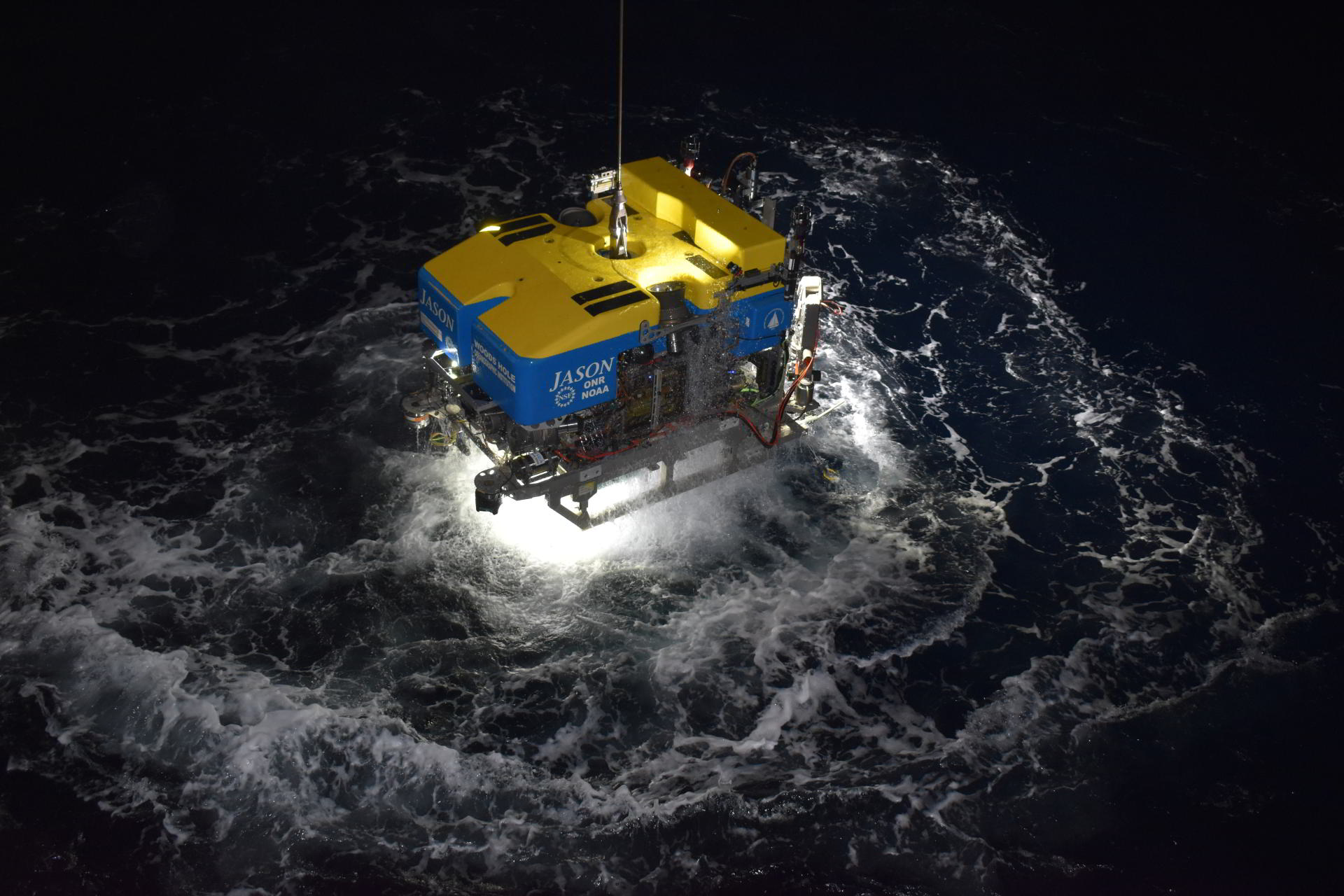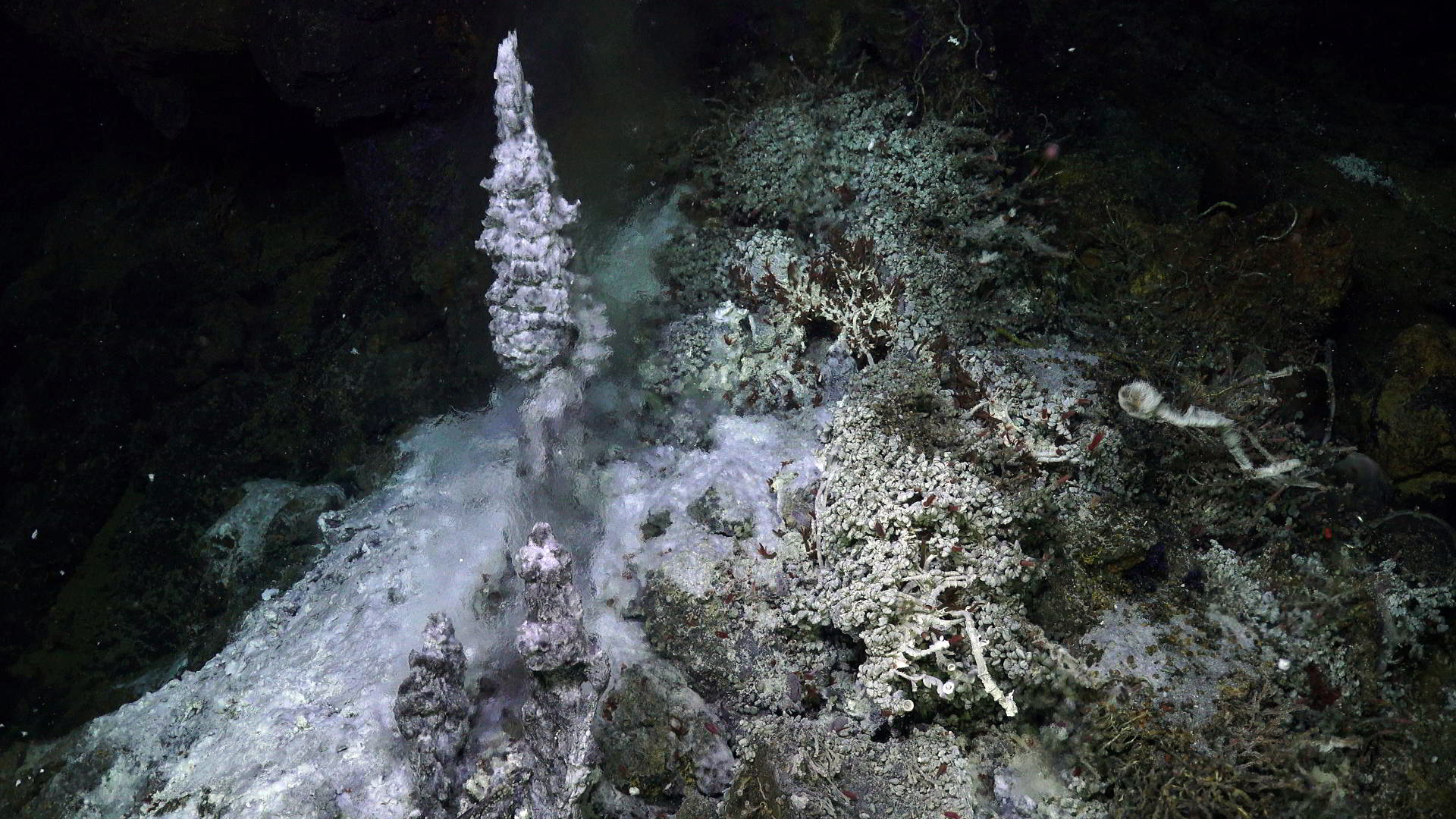Image Archive





























Millions of limpets surround palm worms thriving on the actively venting structure "Mushroom". Credit: UW/NSF-OOI/WHOI: V20.

Beauitful lavender-blue protists thrive at the base of the active chimney 'Mushroom'. Credit: UW/NSF-OOI/WHOI. V20.

A HPIES instrument is about to be released to free fall to the seafloor 2600 m below at the base of Axial Seamount. Credit: University of Washington.

The Deep Profiler vehicle is launched with Jason for installation on the mooring at Axial Base. Credit: University of Washington, V20.

An RCA Deep Profiler vehicle is latched into the clamshell on Jason for installation and Axial Base. Credit: University of Washington. V20

The ROV Jason rises from the deep after diving in the International District Hydrothermal Field. Credit: University of Washington.

A sculpin aka 'blobfish' comes out to greet the ROV at 5000 ft down on the summit of Axial Seamount. Credit: UW/NSF-OOI/WHOI; V20.

The and anhydrite-rich chimlet "Castle" rises from the seafloor. Credit: UW/NSF-OOI/WHOI:V20.

The digital still camera at the Tiny Village site is covered in filamentous bacteria after a year-long deployment. Credit: UW/NSF-OOI/WHOI. V20.

APL engineer, Trina Litchendorf, works on a digital still camera onboard the R/V Thompson during the VISIONS'20 expedition. Credit: University of Washington.

Jason rises from dive J2-1262 with the HD camera secured in the undervator. Credit: UW/NSF-OOI/WHOI. V20

A blob sculpin (Psychrolutes sp.) aka blobfish, at International District on Axial Seamount during VISIONS'20. Credit: UW/NSF-OOI/WHOI V20.

The high definition camera once again lights up the Mushroom hydrothermal edifice. Credit: UW/NSF-OOI/WHOI. V20.

The winched profiler awaits final installation at the Oregon Offshore site. Credit: UW/NSF-OOI/WHOI. V20

The Deep Profiler vehicle is latched onto the mooring cable at Axial Base during the VISIONS 20 expedition. Credit: UW/NSF-OOI/WHOI.V20

An instrumented Deep Profiler is installed at Axial Base - over a 17 month period instrumented vehicles transited over 8 million ft of ocean water. Credit. UW/NSF-OOI/WHOI. V20.

During testing of the cabled high definition camera, which streams live imagery to shore every three hours, the camera lights up Jason at working at nearly a mile beneath the oceans surface on this active volcano. Credit: UW/OOI-NSF. V20.

Final testing of the instrumented shallow profiler components are completed at the RCA logistics prior to mobilization on the R/ V Thompson. Credit: D. Manalang, University of Washington. V20.

An army of instrumented stationary platforms (right) and winched shallow profilers (left) stand guard at Newport, awaiting final integration testing. Credit: D. Manalang, University of Washington. V20

The R/V Thompson begins its 30-day voyage into the NE Pacific to conduct work on the Regional Cabled Array. Credit: R. Scott University of Washington. V20.

Multiple cranes are operational during the intense 1-day mobilization for Leg 1 of the 2020 RCA annual maintenance cruise. Credit: R. Scott, University of Washington, V20

RCA-APL Logistics Operations lead, L. Nielson carefully moves and winched Shallow Profiler platform at the Newport NOAA Facility. Credit: R. Scott, University of Washington. V20

The Thompson steams to the Oregon Offshore site on Leg 1 with a fully loaded deck. Credit. M. Elend, University of Washington. V20.

The fantail is filled with shallow profiler platforms marked by orange syntactic foam, and secondary junction boxes. Credit. M. Elend, University of Washington. V20.

One of the best things of being at sea is seeing the remarkable sunsets. Credit: K. Gonzalez, University of Washington, V20.

Under calm seas, Jason is latched into an winched shallow profiler platform onboard the R/V Thompson. Credit: K. Gonzalez, University of Washington

During the first few days of the VISIONS'20 cruise, the NE Pacific looked like a calm lake - beautiful it was for transiting and working. Credit: K. Gonzalez, University of Washington.

Numerous screens inside the Jason control van provide a wealth of data to the ROV and science-engineering team, here working at Slope Base taking sediment push cores. Credit. K. Gonzalez, University of Washington.
- Anemone
- Animal
- Arthropod
- ASHES
- Axial
- Axial Base
- Axial Biology
- Axial Caldera
- Bacteria
- Basalt Lava
- BEP
- Biofouling
- biolgoy
- Biology
- Camds
- Camera
- Camhd
- Central Caldera
- Ciliates
- Cnidaria
- Coastal Biology
- Crab
- Deep Profiler Mooring
- Dive Highlights
- Eastern Caldera
- Echinoderms
- Endurance Array
- Engineering Team
- ENLIGHTEN 10
- Exploratorium
- Fish
- Geology
- HD Camera
- HPIES
- Hydrate Ridge
- Hydrates
- Hydrophone
- Hydrothermal Vents
- Illustration
- Inshore 80 Meters
- Instrument
- International District
- J-BOX
- Jason
- Jellyfish
- Junction Box
- K12
- Lava
- Mollusk
- Moorings
- Nodes
- Nudibranch
- Octopus
- OOI
- Oregon Offshore
- Oregon Offshore 600 m
- Oregon Shelf
- Oregon Slope Base
- People
- PN1B
- PN1D
- Polychaetes
- PPSDN
- Primary Node
- RASFL
- ROCLS
- ROPOS
- ROPOS Dives
- ROV Team
- RV Revelle
- RV Sikuliaq
- RV Thompson
- Salp
- Sample
- SC13
- Science Team
- Sea Cucumber
- Sea Star
- Sea Urchin
- Seafloor
- Seismometer
- Sensors
- Shallow Profiler Mooring
- Shark
- Shipboard
- Shore Station
- Slope Base
- Smoker
- Soft Coral
- Southern Hydrate Ridge
- Sponge
- Squid
- Students
- Students & Guest Participants
- Tmpsf
- Tubeworms
- VISIONS 11 Leg 1
- VISIONS 11 Leg 2
- VISIONS 11 Viewers
- VISIONS 13
- VISIONS 14
- VISIONS 15
- VISIONS 16
- VISIONS 17
- VISIONS 18
- VISIONS 20
- VISIONS 22
- VISIONS 23
- Visualization
